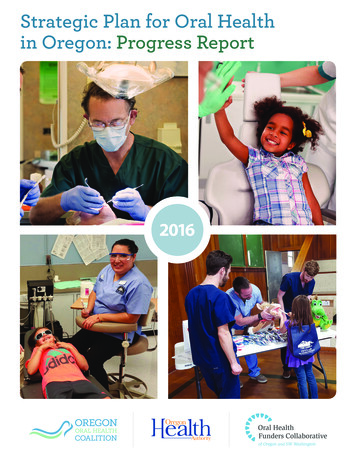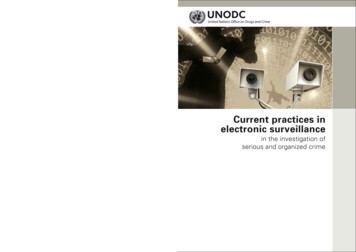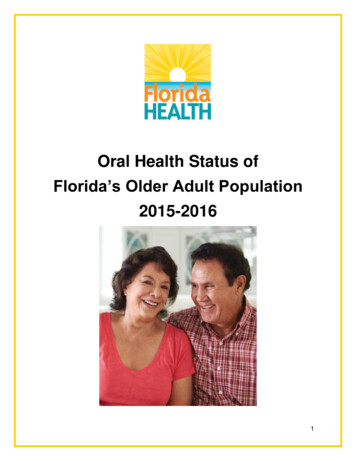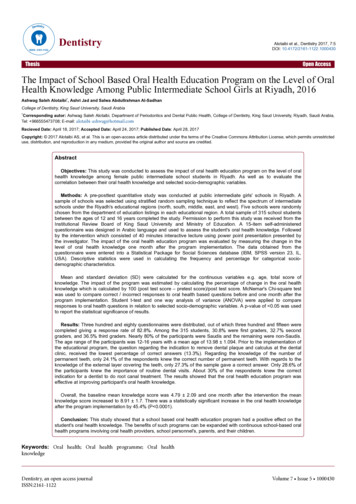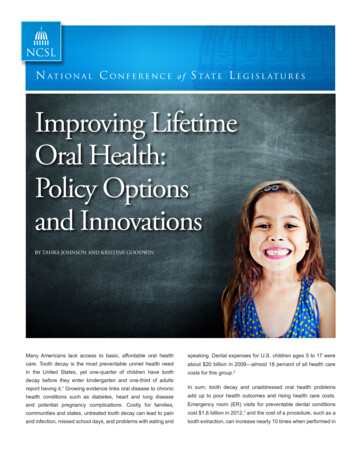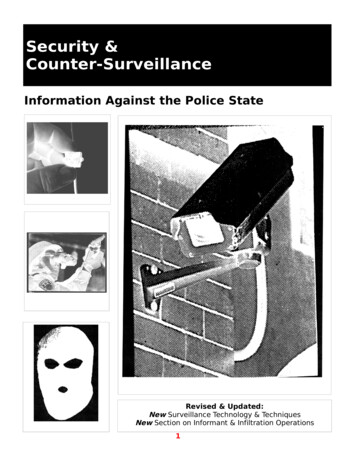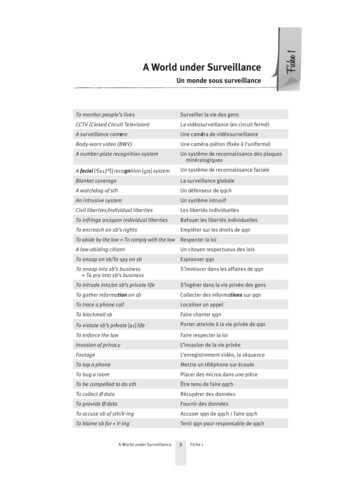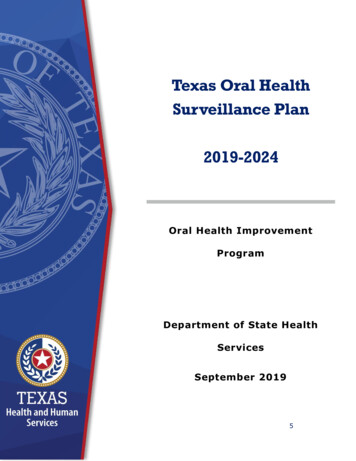
Transcription
Texas Oral HealthSurveillance Plan2019-2024Oral Health ImprovementProgramDepartment of State HealthServicesSeptember 20195
ContentsContents . 2Executive Summary . 4Introduction . 5The Purpose of Public Health Surveillance . 5The Public Health Importance of Oral Health . 5Texas Oral Health Surveillance System. 10Purpose . 10TOHSS Plan Objectives . 11Data Dissemination and Evaluation of TOHSS . 11Dissemination of TOHSS Data and Information . 11Confidentiality of TOHSS Data . 12Evaluation . 12Acknowledgements . 13References. 14Appendix A. Acronyms and Data Dictionary . 17List of Acronyms . 17Data Dictionary . 19Texas Oral Health Basic Screening Survey (BSS) . 19Behavior Risk Factor Surveillance System (BRFSS) . 19Children’s Health Insurance Program (CHIP) . 20Medical Expenditure Panel Survey (MEPS) . 20National Birth Defects Prevention Network (NBDPN) . 20National Survey of Children’s Health (NSCH) . 21National Oral Health Surveillance System (NOHSS). 21Pregnancy Risk Assessment Monitoring System (PRAMS). 21School Physical Activity and Nutrition Survey (SPAN) . 22School-Based Health Center (SBHC) . 22Texas Birth Defects Registry (TBDR) . 22Texas Cancer Registry (TCR). 22The Office of Head Start Program Information Report (PIR) . 23Uniform Data System (UDS) . 23Water Fluoridation Reporting System (WFRS) . 23Youth Risk Behavior Survey (YRBS) . 23Appendix B. Texas Oral Health Surveillance Plan – LOGIC MODEL . 25Appendix C. HP 2020 Oral Health Indicators Currently Monitored byTOHSS . 26HP 2020 Oral Health Indicators NOT Currently Monitored by TOHSS . 27Appendix D. Oral Health Data Collection Frequencies . 28Table 1: Oral Health Data Collection Sources and Time Frames . 28Appendix E. Oral Health Indicators and Data Sources . 29Oral Health Indicators . 29Infants & Children . 29
Children with Special Health Care Needs . 29Adolescents . 30Adults . 30Pregnant Women . 31School-Based Dental Services . 31All Ages FQHC . 32Community Water Fluoridation . 32Workforce. 32Data Sources . 32
Executive SummaryPoor oral health impacts a person’s ability to eat, speak, work, communicate andlearn. Although most oral diseases and conditions are preventable, virtually alladults—and many children—have experienced some oral disease. Serious oralhealth disparities exist by race, age, geography, and income. The costs of oraldisease treatment are significant, and most of those costs are paid byindividuals or through private insurance. Much of the population cannot afforddental care or do not take advantage of public insurance benefits.The Texas Oral Health Surveillance System (TOHSS) is an initiative of the TexasDepartment of State Health Services (DSHS) Oral Health Improvement Program(OHIP). TOHSS monitors trends in oral disease, such as early childhood caries,tooth loss, and oral and pharyngeal cancer; the prevalence of preventiveservices, such as dental sealants, community water fluoridation, and fluoridevarnish; and dental service utilization, through such programs as the Early andPeriodic Screening, Diagnosis, and Treatment (EPSDT) Program and theChildren’s Health Insurance Program (CHIP).By collecting and analyzing trends, essential oral health information is availablefor stakeholders and policymakers to evaluate current systems and identifypotential resources needed to improve the oral health of all Texans in the future.The following report provides a detailed outline of OHIP’s five-year plan forcollecting and disseminating oral health data.
IntroductionThe Purpose of Public Health SurveillanceThe 1988 Institute of Medicine (IOM) report on the future of public healthoutlines three core functions for public health: assessment, policy developmentand assurance. In that report, updated in 2003, the IOM recommended thatevery public health agency regularly and systematically collect, assemble,analyze, and disseminate information on community health status to carry outthe assessment function. Public health agencies accomplish this task throughpublic health surveillance -- the ongoing, systematic collection, analysis andinterpretation of health data (Teutsch & Churchill, 2000). Surveillance isessential for planning, implementing, and evaluating public health practice and,ideally, is closely integrated with data dissemination to public health decisionmakers and other stakeholders (Hall et al., 2012). The overarching purpose ofpublic health surveillance is to provide actionable health information toguide public health policy and programs (Smith et al., 2013).The Public Health Importance of Oral HealthThe 2000 report, Oral Health in America: A Report of the Surgeon General,states that oral health is more than healthy teeth (Texas Department of Healthand Human Services (HHS), 2000). Oral health means being free of chronic oraland facial pain, oral and pharyngeal (throat) cancers, oral soft tissue lesions,cleft lip or other birth defects, oral injuries due to sports-related trauma orphysical abuse, and scores of other diseases and disorders that affect the oral,dental, and craniofacial tissues. The report notes that oral health is integral togeneral health and stresses the importance of good oral health at both theindividual and population (public health) level.In the United States, the two most common oral diseases are dental caries(tooth decay) and periodontal (gum) disease. Although less common, cancers ofthe oral cavity and pharynx, orofacial clefts (cleft lip and cleft palate),malocclusion, orofacial pain, and other oral health problems can severely affectgeneral health and quality of life. For example, poor oral health impacts theability to eat, communicate and learn. It affects how we look and how weinteract with others because of low self-esteem. Missing or decayed teeth canalso make it difficult to find jobs where public interaction is important.Each oral disease or condition, also referred to as an oral health outcome, isinfluenced by a variety of factors including access to dental care, individual risk
factors and risk determinants, availability of interventions, workforce andfinancing issues, public health infrastructure and public policies (See Figure 1).Figure 1: Factors Impacting Oral Health OutcomesFollowing is a brief overview of the major oral health outcomes includingcommon risk factors and intervention strategies.Dental CariesDental caries, also known as tooth decay, has been described as the single mostcommon chronic childhood disease (HHS, 2000). Healthy People 2020, managedby the U.S. Department of Health and Human Services (HHS), proposed a goalof 49 percent for the proportion of children aged six to nine with dental cariesexperience in any of their teeth (2010). During the 2017-2018 school year, 67.1percent of Texas third graders were found to have dental caries experience(DSHS, 2018).The impact of dental caries accumulates over time; of those 20-64 years of agein the U.S., 91 percent had caries experience (treated or untreated decay) (Dyeet al., 2015b). Additionally, the prevalence of dental caries experience isgenerally higher in low-income and minority populations, representing asignificant health disparity.There are effective preventive intervention strategies for dental caries. Cariesprevalence and severity can be reduced by appropriate use of fluorides throughcommunity water fluoridation, personal or professional topical fluorideapplications and use of toothpaste with fluoride. Center for Disease Control andPrevention (CDC) has recognized community water fluoridation as one of tengreat public health achievements of the 20th century, yet not everyone hasaccess to fluoridated water (CDC, 1999).
Dental sealants are another effective intervention, preventing cariesdevelopment in the pits and fissures of molar (back) teeth (Ahovuo-Saloranta etal., 2017). Dental sealants can be applied in dental offices or communitysettings (e.g., schools), yet far too few children are benefiting from this provenpreventive service; in 2011-2012 in the U.S., only 31 percent of 6 to 8-yearolds, 49 percent of 9 to 11-year-olds and 43 percent of 12 to 19-year-olds haddental sealants on at least one permanent molar (Dye et al., 2015a). In Texas in2017-2018, 41.4 percent of third graders had a dental sealant on at least onepermanent molar (DSHS, 2018).To reduce the prevalence of untreated dental decay, all individuals, regardless ofincome or dental insurance coverage, must have access to restorative dentalcare. Access to dental care, in turn, is influenced by infrastructure, workforce,financing and policy factors, including availability of low-cost clinics, dentist-topopulation ratio, percent of dentists accepting government-funded dentalinsurance, reimbursement rates for government-funded programs, plus dentalpractice acts involving supervision, scope of practice and reimbursement.Periodontal DiseasePeriodontal disease is another common public health problem in the UnitedStates. More than 46 percent of adults 30 years and older have destructiveperiodontal disease (periodontitis), with 9 percent having severe periodontitischaracterized by loss of the bony structure supporting the teeth and resulting inpartial or total tooth loss (Eke et al., 2015). Among adults aged 65 years andolder, 68 percent have some form of periodontitis with 11 percent classified assevere (Eke et al., 2015). As with dental caries, substantial oral healthdisparities exist. The prevalence of periodontitis is higher in men, Hispanics,adults with less than a high school education, adults below 100 percent of theFederal Poverty Level, and current smokers (Eke et al., 2015). The mostcommon risk factor for periodontitis is smoking. Texas Behavioral Risk FactorSurveillance System (BRFSS) data from 2017 showed 35.7 percent of Texanshave a history of tobacco use (DSHS). Smoked tobacco use prevention andcessation could be a potentially effective population- level intervention strategy.Cancers of the Oral Cavity and PharynxAlthough substantially less common than dental caries and periodontitis, cancersof the oral cavity and pharynx have a significant impact on the health caresystem and should be included in public health surveillance. Cancers of the oralcavity and pharynx are more common in men than women, among those with ahistory of tobacco or heavy alcohol use, and individuals infected with humanpapillomavirus (HPV). From 2009-2013, the number of new cases of oral cavityand pharynx cancer was 11.1 per 100,000 men and women per year (SEER,n.d.). In 2016, there were 3,157 new cases and 660 reported deaths in Texasalone (Texas Cancer Registry (TCR), 2016). Currently, the primary public health
and personal prevention strategies for cancer of the oral cavity are tobaccocessation and no more than moderate alcohol consumption. The leading cause oforopharyngeal cancer is HPV infection (CDC, 2018).Orofacial CleftsFor reporting purposes, orofacial clefts are generally classified as either (1) cleftpalate without cleft lip or (2) cleft lip with and without cleft palate. Based on2004-2006 data from 14 state birth defects tracking programs, the estimatedincidence of cleft palate without cleft lip is 1 in 1,574 live U.S. births (2,651cases annually), and the incidence of cleft lip with or without cleft palate is 1 in940 live births (4,437 cases annually) (Parker et al., 2010). In Texas, theprevalence of cleft palates without cleft lip is 5.90 in 10,000 births and theprevalence of cleft lip with or without cleft palate is 10.75 in 10,000 births(DHHS, Birth Defects Registry, 2014). Orofacial clefts in the U.S. are mostcommon among American Indian and Asian children. Orofacial clefts are oftencaused by a combination of genetic and environmental causes but in manychildren a cause cannot be determined. Risk factors include family history andmaternal use of tobacco, alcohol and street drugs during pregnancy. Preventionstrategies include folic acid supplementation plus tobacco, alcohol and drug usecessation during the prenatal period.Disparities in Access to Dental CareAs previously mentioned, oral health disparities are profound in the UnitedStates. Children in lower-income families have higher dental caries rates thannon-poor children; minority populations have worse oral health than thepopulation in general; and rural residents have worse oral health than urbanresidents (DHHS, 2000). These disparities start in childhood and persistthroughout the lifecycle.Limited or infrequent access to dental care contributes to poor oral health.Unfortunately, in the U.S. about 46 percent of children aged 2-17 years did notvisit a dentist in 2013, with black (53 percent) and Hispanic children (51percent) more likely to have not visited a dentist compared with white children(41 percent) (Agency for Healthcare Research and Quality (AHRQ), 2016). ForTexas adults 18 years and older, 40.6 percent report having no dental visitwithin the past year, with substantial disparities by education, income andrace/ethnicity. For those with an annual income less than 15,000, 58.8 percenthad no dental visit compared with 28.3 percent of those with an income of 50,000 or more (CDC, 2016).Financial ImplicationsThe cost of treating dental disease is significant. According to the Centers forMedicare & Medicaid Services (CMS), spending for dental services in 2014 was
113.5 billion, with out-of-pocket personal spending accounting forapproximately 40 percent of all dental spending (2018).SummaryIn summary, the public health implications of poor oral health status are vast.Poor oral health impacts a person’s ability to eat, speak, work, communicate andlearn. Although most oral diseases and conditions are preventable, virtually alladults—and many children—have experienced some oral disease. Serious oralhealth disparities exist by race, age, geography, and income. The costs of oraldisease treatment are significant, and most of those costs are paid byindividuals or through private insurance. Much of the population cannot afforddental care or do not take advantage of public insurance benefits.CDC guidelines for evaluating public health surveillance systems recommendthat health-related events (in this case oral diseases and conditions) beconsidered for surveillance if they affect many people, require largeexpenditures of resources, are largely preventable, and are of public healthimportance (German et al., 2001). Based on these criteria, oral healthoutcomes, associated health behaviors, and other factors linked to oral healthare included in TOHSS.
Texas Oral Health Surveillance SystemThe Texas Oral Health Surveillance System (TOHSS) is an initiative of the TexasDepartment of State Health Services (DSHS) Oral Health Improvement Program(OHIP). OHIP defines public health surveillance as the ongoing systematiccollection, analysis, and interpretation of health data for purposes of improvinghealth. An essential component of the system is the dissemination and use ofsurveillance data to improve evidenced-based decision making.TOHSS monitors trends in oral disease, such as early childhood caries, toothloss, and oral and pharyngeal cancer; the prevalence of preventive services,such as dental sealants, community water fluoridation, and fluoride varnish; anddental service utilization, through such programs as the Early and PeriodicScreening, Diagnosis, and Treatment (EPSDT) Program and the Children’sHealth Insurance Program (CHIP).By collecting and analyzing trends, essential oral health information is availablefor stakeholders and policymakers to evaluate current systems and identifypotential resources needed to improve the oral health of all Texans in the future.PurposeThe purpose of the TOHSS plan is twofold:1. to establish and maintain a system of continuous monitoring and timelycommunication of oral health findings and2. to increase the amount of quality oral health data available for evidencebased decision-making.Assessment is a key objective of Texas’s public health efforts and includescollection, analysis, interpretation, and dissemination of data. TOHSS provides amechanism to monitor oral disease trends over time.A well-maintained surveillance system can be used to guide the allocation ofresources for disease prevention and oral health promotion opportunities.Assessment and evaluation of oral disease trends may also support thedevelopment of oral health policy.Information contained in the surveillance system is provided as a resource tohelp oral health stakeholders in Texas find reputable sources of oral health dataand information for decision making and planning. Interpretation and use of thedata retrieved from this surveillance system are solely the responsibility of theuser, and information and may not necessarily represent the official views ofDSHS OHIP.
TOHSS Plan ObjectivesThe implementation and maintenance of a comprehensive oral health assessment andsurveillance system is a critical requirement of any oral health planning effort.Objectives for TOHSS are:1. Increase the amount of quality oral health data available to oral healthstakeholders for planning and decision-making by submitting questions forinclusion to three state surveys by 2024.2. Increase the amount of quality oral health data available to oral healthstakeholders for planning and decision-making by conducting Basic ScreeningSurveys (BSS) every five years.3. Ensure useful and current data is available by reviewing and updating contentquarterly.4. Disseminate oral health data and findings in a usable, easy-to-understandformat as evidenced by user satisfaction survey results of seventy percentsatisfied. The survey will be conducted near the end of the plan period.5. Identify data gaps by conducting a gap analysis report by 2024.6. Monitor the oral disease burden of Texans by developing a burden document by2024.7. Compare Texas data to national and local indicators that assess overall oralhealth by completing a comparison report by 2024.Data Dissemination and Evaluation of TOHSSDissemination of TOHSS Data and InformationDSHS OHIP will provide oral health information to the public through the program’swebsite, program listservs, social media, reports, briefs, infographics, publicpresentations, and any other distribution methods OHIP finds appropriate. Availabledata will be shared with the public on the TOHSS webpage, which will contain asummary of the results from the various indicators incorporated in the TOHSS. Theintent of the TOHSS webpage is to help disseminate timely oral health data so thatresponsible parties, policymakers, the professional community, and the public canreadily understand the implications of the information. TOHSS will also provideinformation at the national level to NOHSS and the ASTDD State Synopses, asrequired and available. Evolution of TOHSS will allow further refinement of theindicators and continued improvement in the ability to communicate data, includingtrend analysis.
Confidentiality of TOHSS DataManagement of all health-related data, both primary and secondary, meets HealthInsurance Portability and Accountability Act (HIPAA) standards for patient privacy,data confidentiality, and data integration. Access to protected health information (PHI)is limited to the surveillance staff for analysis purposes only. Program staff will viewPHI only when necessary. No PHI is released to partners or to the public. Onlyaggregated results are reported.EvaluationTOHSS will be evaluated to ensure that issues and trends of oral health importanceare being monitored efficiently and effectively. OHIP will engage stakeholdersperiodically in an evaluation of TOHSS, following the six tasks proposed in “UpdatedGuidelines for Evaluating Surveillance Systems” (Guidelines) published in Morbidityand Mortality Weekly Report, July 27, 2001/(50) RR13; 1-35.OHIP adapted the six tasks proposed in “Updating Guidelines for EvaluatingSurveillance Systems” to become program specific: Engage Texas stakeholders;Describe TOHSS and validate its purpose and objectives;Evaluate the surveillance plan;Gather credible evidence regarding the performance of TOHSS;Justify and state conclusions, make recommendations; andEnsure the use of evaluation findings, that lessons learned are shared, and thatthe TOHSS objectives are met.
AcknowledgementsOHIP would like to thank the following individuals and groups for their contributions to the2019-2024 TOHSS Plan: ASTDD, for providing the Oral Health Surveillance Plan Template necessary to developan informative and comprehensive state oral health surveillance plan. Debra Saxton, M.S., Senior Epidemiologist in the DSHS Maternal and Child HealthEpidemiology Unit OHIP Regional Dental Teams, for their dedication, including many miles of travel andnights away from home, to screen preschool- and school-aged children for OHIP BSSdata.And finally, OHIP would like to thank all the other people, agencies, and organizations thathelp make oral health data available in Texas. It is important, and it is appreciated.9
References Agency for Healthcare Research and Quality (AHRQ). (2016). MEPS Summary Tables:Cross-sectional Race/Ethnicity, Dental visits in 2016. Retrieved fromhttps://meps.ahrq.gov/mepstrends/hc use/ Ahovuo-Saloranta, A., Forss, H., Walsh, T., Nordblad, A., Mäkelä, M., & Worthington,H. (2017, July 31). Sealants for preventing tooth decay in permanent teeth. Retrievedfrom https://www.cochrane.org/CD001830/ORAL sealants-preventing-tooth-decaypermanent-teeth Centers for Disease Control and Prevention (CDC). (1999, April 1). Ten Great PublicHealth Achievements—United States, 1900-1999. Retrieved 6796.htm Centers for Disease Control and Prevention (CDC). (2016). Oral Health Data. Retrievedfrom http://www.cdc.gov/oralhealthdata/ Centers for Disease Control and Prevention (CDC). (2018). HPV and OropharyngealCancer. Retrieved fromhttps://www.cdc.gov/cancer/hpv/basic info/hpv oropharyngeal.htm. Centers for Medicare & Medicaid Services (CMS). (2018, April 17). National HealthExpenditure Data. Retrieved from ExpendData/index.html Dye, B., Thornton-Evans, G., Li, X., & Iafolla, T. (2015, March 05). Dental Caries andSealant Prevalence in Children and Adolescents in the United States, 2011–2012.Retrieved from he-united-states-2011-2012/14
Dye, B., Thornton-Evans, G., Li, X., & Iafolla, T. (2015, May 14). Dental Caries andTooth Loss in Adults in the United States, 2011–2012. Retrieved 2012/ Eke, P. I., Dye, B. A., Wei, L., Slade, G. D., Thornton-Evans, G. O., Borgnakke, W. S.,. . . Genco, R. J. (2015). Update on Prevalence of Periodontitis in Adults in the UnitedStates: NHANES 2009 to 2012. Journal of Periodontology,86(5), 611-622.doi:10.1902/jop.2015.140520 German, R., MPH, Lee, L., PhD, Horan, J., MD, MPH, Milstein, R., MPH, Pertowski, C.,MD, & Waller, M. (2001). Updated Guidelines for Evaluating Public Health SurveillanceSystems. Retrieved 13a1.htm Hall, H. I., PhD, Correa, A., MD, Yoon, P., ScD, & Braden, C., MD. (2012, July 27).Lexicon, Definitions, and Conceptual Framework for Public Health Surveillance.Retrieved from .htm Healthy People. (2010). Oral Health. Retrieved ctives/topic/oral-health Institute of Medicine (IOM). (1988). Future of Public Health. Washington, DC: NationalAcademies Press. Parker, S., Mai, C., Canfield, M., Rickard, R., Wang, Y., Meyer, R., Anderson, P.,Mason, C., Collins, J., Kirby, R., Correa, A., National Birth Defects Prevention Network.(2010). Updated National Birth Prevalence Estimates for Selected Birth Defects CDC.Retrieved from irthdefectskeyfindings.html15
Seer. (n.d.). Cancer of the Oral Cavity and Pharynx - Cancer Stat Facts. Retrievedfrom l Smith, P. F., Hadler, J. L., Stanbury, M., Rolfs, R. T., Hopkins, R. S., & CSTESurveillance Strategy Group. (2013). “Blueprint Version 2.0”. Journal of Public HealthManagement and Practice, 19(3), 231-239. doi:10.1097/phh.0b013e318262906e Teutsch, S. M., & Churchill, R. E. (2000). Principles and Practice of Public HealthSurveillance (2nd ed.). New York, New York: Oxford University Press. Texas Cancer Registry (TCR). (2016). Age-Adjusted Invasive Cancer Incidence Rates inTexas: Oral Cavity and Pharynx, 2016. Cancer Rates in Texas. Retrieved fromhttps://www.cancer-rates.info/tx/ Texas Department of Health and Human Services (DHHS), Birth Defects Registry(BDR). (2014). Texas Birth Defects by Mother's Race/Ethnicity, Years: 1999- 2014.Retrieved from efects Texas Department of Health and Human Services (HHS). (2000). Oral Health inAmerica: A report of the Surgeon General. Retrieved tics/surgeon-general Texas Department of State Health Services (DSHS), Community Health Improvement,Maternal and Child Health Section, Maternal and Child Health Epidemiology. (2018).Texas Overall Findings 3rd Grade BSS 2018 – Final.pdf. Request a copy atdental@dshs.texas.gov Texas Department of State Health Services (DSHS). (2017). Texas Health Data: TexasBehavioral Risk Factor Surveillance System (BRFSS) Data Visualizations – SelectedRisk Factors. Retrieved eys/BRFSS16
Appendix A. Acronyms and Data DictionaryList of AcronymsADAAmerican Dental AssociationAHRQAgency for Healthcare Research and QualityASTDDAssociation of State and Territorial Dental DirectorsATOHMITAdvancing the Oral Health Movement in TexasBRFSSBehavioral Risk Factor Surveillance SystemBSSBasic Screening SurveyCARTSCHIP Annual Reporting Template SystemCDCCenters for Disease Control and PreventionCHICommunity Health ImprovementCHIPChildren’s Health Insurance ProgramCHSCenter for Health StatisticsCMSCenters for Medicare & Medicaid ServicesCMS-416Annual Early and Periodic Screening, Diagnostic and Treatment (EPSDT) ReportCSTECouncil of State and Territorial EpidemiologistsDSHSDepartment of State Health Services (Texas)EPAEnvironmental Protection AgencyEPSDTEarly and Periodic Screening, Diagnosis, and TreatmentFFYFederal Fiscal YearFQHCFederally Qualified Health CenterHHSCHealth and Human Services Commission (Texas)HP2020Healthy People 2020HPSAHealth Professional Shortage AreaHRSAHealth Resources and Services AdministrationHSHead StartMCDMedicaid and CHIP DivisionMEPSMedical Expenditure Panel SurveyNBDPNNational Birth Defects Prevention NetworkNCHSNational Center for Health StatisticsNCINational Cancer Institute17
NHANESNational Health and Nutrition Examination SurveyNOHSSNational Oral Health Surveillance SystemNSCHNational Survey of Children’s HealthNS-CSHCNNational Survey of Children with Special Health Care NeedsNSLPNational School Lunch ProgramOHIPOral Health Improvement ProgramPHIProt
public health surveillance is to provide actionable health information to guide public health policy and programs (Smith et al., 2013). The Public Health Importance of Oral Health The 2000 report, Oral Health in America: A Report of the Surgeon General, states that oral health is more than healthy teeth (Texas Department of Health
